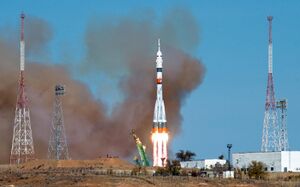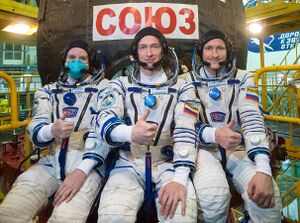Engineering:Soyuz MS-17
 Favor launches atop a Soyuz-2.1a | |
| Names | ISS 63S |
|---|---|
| Mission type | Crewed mission to ISS |
| Operator | Roscosmos |
| COSPAR ID | 2020-072A |
| SATCAT no. | 46613 |
| Mission duration | 184 days, 23 hours, 10 minutes |
| Spacecraft properties | |
| Spacecraft | Soyuz MS No.747 Favor [1] |
| Manufacturer | RSC Energia |
| Crew | |
| Members |
|
| Start of mission | |
| Launch date | 14 October 2020, 05:45:04 UTC[2][3][4][5] |
| Rocket | Soyuz-2.1a (s/n Х15000-045) |
| Launch site | Baikonur, Site 31 |
| Contractor | RSC Progress |
| End of mission | |
| Landing date | 17 April 2021, 04:55 UTC[6] |
| Landing site | Kazakh Steppe, Kazakhstan |
| Orbital parameters | |
| Reference system | Geocentric orbit |
| Regime | Low Earth orbit |
| Inclination | 51.66° |
| Docking with ISS | |
| Docking port | Rassvet nadir |
| Docking date | 14 October 2020, 08:48:47 UTC [7][8] |
| Undocking date | 19 March 2021, 16:38:27 UTC [9][10] |
| Time docked | 156 days, 7 hours and 49 minutes |
| Docking with ISS (Relocation) | |
| Docking port | Poisk zenith |
| Docking date | 19 March 2021, 17:12:35 UTC [10] |
| Undocking date | 17 April 2021, 01:34 UTC [6] |
| Time docked | 28 days, 8 hours and 21 minutes |
 Rubins, Ryzhikov, and Kud-Sverchkov | |
Soyuz MS-17 was a Soyuz spaceflight that was launched on 14 October 2020.[4][11] It transported three crew members of the Expedition 63/64 crew to the International Space Station. Soyuz MS-17 was the 145th crewed flight of a Soyuz spacecraft. The crew consisted of a Russian commander and a Russian and American flight engineer.[12][13][14]
The mission marked the first use of a new "ultrafast" two-orbit rendezvous flight plan with the Soyuz, which saw Soyuz MS-17 arrive at the ISS within approximately three hours after the launch.[3][15][16][8]
On 19 March 2021, the crew of Soyuz MS-17 boarded their spacecraft to relocate it from Rassvet to Poisk to make way for the arrival and docking of the Soyuz MS-18 spacecraft,[9] which launched on 9 April 2021 carrying cosmonauts Oleg Novitsky, Pyotr Dubrov and NASA astronaut, Mark T. Vande Hei to the ISS ahead of a six-month stay. The two spacecraft had a nine-day handover period before Soyuz MS-17 departed. This is necessary to avoid de-crewing the Russian Orbital Segment (ROS) of the ISS since no Russian cosmonaut was present aboard SpaceX Crew-1.[11]
Crew
| Position | Crew member | |
|---|---|---|
| Commander | Expedition 63/64 Second spaceflight | |
| Flight Engineer 1 | Expedition 63/64 First spaceflight | |
| Flight Engineer 2 | Expedition 63/64 Second spaceflight | |
Backup crew
| Position | Crew member | |
|---|---|---|
| Commander | ||
| Flight Engineer 1 | ||
| Flight Engineer 2 | ||
Reserve crew
| Position | Crew member | |
|---|---|---|
| Commander | ||
| Flight Engineer 1 | ||
Crew notes
Early planning had listed Russian cosmonaut Nikolai Chub as the mission's Flight Engineer 2, pending a NASA decision on whether they would purchase more seats on the Soyuz. In May 2020, NASA purchased a Soyuz seat and assigned NASA astronaut Kathleen Rubins to the Flight Engineer 2 position, backed up by astronaut Mark T. Vande Hei.[17][20]
Originally Russian cosmonauts Anatoli Ivanishin and Ivan Vagner were set to fly as Commander and Flight Engineer 1 respectively. In February 2020, however, the two cosmonauts were moved to the Soyuz MS-16 flight due to medical issues with the commander of Soyuz MS-16, Nikolai Tikhonov. Ivanishin and Vagner were replaced by Ryzhikov and Kud-Sverchkov. Babkin remains an active cosmonaut, but has not yet been to space, while Tikhonov has retired from Roscosmos' astronaut corps.
Reacting to the COVID-19 pandemic, Roscosmos implemented a two-cosmonaut reserve crew to ensure the flight could go on with no delays, in the unlikely event both the prime and backup crews fall ill. It was not confirmed whether NASA planned to add an astronaut of their own to the reserve crew.[21]
Gallery
References
- ↑ "Soyuz-MS 01 - 20 (11F732A48)". Gunter's Space Page. 16 April 2021. https://space.skyrocket.de/doc_sdat/soyuz-ms.htm.
- ↑ Clark, Stephen (14 October 2020). "Live coverage: Soyuz crew begins flight to International Space Station". Spaceflight Now. https://spaceflightnow.com/2020/10/14/soyuz-ms-17-mission-status-center/.
- ↑ 3.0 3.1 Zak, Anatoly (13 October 2020). "Soyuz MS-17 to lift off with fresh ISS crew". RussianSpaceWeb.com. http://www.russianspaceweb.com/soyuz-ms-17.html.
- ↑ 4.0 4.1 "NASA Astronaut Kate Rubins, Crewmates to Discuss Upcoming Spaceflight" (Press release). NASA. 25 June 2020. Retrieved 4 September 2020.
 This article incorporates text from this source, which is in the public domain.
This article incorporates text from this source, which is in the public domain.
- ↑ "Источник: НАСА хочет купить еще одно место в российском "Союзе"" (in ru). RIA Novosti. 22 October 2019. https://ria.ru/20191022/1560048196.html.
- ↑ 6.0 6.1 "NASA Astronaut Kate Rubins, Crewmates Return Safely to Earth". NASA (Press release). 16 April 2021. Retrieved 17 April 2021.
- ↑ Becker, Joachim (14 October 2020). "Soyuz MS-17". SpaceFacts. http://www.spacefacts.de/mission/english/soyuz-ms-17.htm.
- ↑ 8.0 8.1 Harwood, William (14 October 2020). "Soyuz crew docks with International Space Station". Spaceflight Now. https://spaceflightnow.com/2020/10/14/soyuz-crew-docks-with-international-space-station/.
- ↑ 9.0 9.1 Pearlman, Robert Z. (19 March 2021). "Space station crew moves Soyuz spacecraft to new parking spot ahead of new arrivals". SPACE.com. https://www.space.com/soyuz-spacecraft-docking-port-move-space-station.
- ↑ 10.0 10.1 "Relocations of Manned Spacecrafts [sic]". 2021-03-21. http://www.spacefacts.de/english/e_relocations.htm.
- ↑ 11.0 11.1 Zak, Anatoly (1 January 2020). "Russian space program in 2020: Soyuz MS-17". RussianSpaceWeb.com. http://www.russianspaceweb.com/2020.html#soyuz_ms17.
- ↑ Becker, Joachim (11 June 2020). "Expedition 64 Report". SpaceFacts. http://www.spacefacts.de/iss/english/exp_64.htm.
- ↑ Baylor, Michael (1 April 2020). "Status - Soyuz MS-17". Next Spaceflight. https://nextspaceflight.com/launches/details/2408.
- ↑ Harwood, William (13 October 2020). "NASA uses final purchased Soyuz seat for Wednesday flight to station". Spaceflight Now. https://spaceflightnow.com/2020/10/13/nasa-uses-final-purchased-soyuz-seat-for-wednesday-flight-to-station/.
- ↑ Clark, Stephen (12 October 2020). "Russian rocket for next space station crew transferred to launch pad". Spaceflight Now. https://spaceflightnow.com/2020/10/12/russian-rocket-for-next-space-station-crew-transferred-to-launch-pad/.
- ↑ "Грузовой корабль "Прогресс" полетит к МКС по сверхбыстрой схеме" (in ru). РИА Новости. 20 March 2020. https://ria.ru/20200320/1568876126.html.
- ↑ 17.0 17.1 "Роскосмос подтвердил подписание контракта на доставку астронавта NASA на корабле "Союз"" (in ru). ТАSS. https://tass.ru/kosmos/8456907.
- ↑ @anik1982space (9 May 2020). "Вот и новые составы российских экипажей «Союза МС-17» стали известны из пресс-релиза аэропорта Жуковский.
Основной: Сергей Рыжиков, Сергей Кудь-Сверчков.
Дублирующий: Олег Новицкий, Пётр Дубров.
К сожалению, Николая Тихонова и Андрея Бабкина нет..." (in ru). https://twitter.com/anik1982space/status/1259112811407564801. - ↑ "Flight crew assignments". NASASpaceFlight.com. https://forum.nasaspaceflight.com/index.php?topic=740.msg2087213#new.
- ↑ "NASA Assigns Astronaut Kate Rubins to Expedition 63/64 Space Station Crew". M20-060 (Press release). NASA. 3 June 2020. Retrieved 5 June 2020.
 This article incorporates text from this source, which is in the public domain.
This article incorporates text from this source, which is in the public domain.
- ↑ "Новости. Утвержден экипаж корабля "Союз МС-17"" [The crew of the Soyuz MS-17 spacecraft was approved]. roscosmos.ru (Press release) (in русский). Roscosmos. Retrieved 11 June 2020.
External links





